ECU MITSUBISHI MIRAGE G4 2018 (in English) User Guide
[x] Cancel search | Manufacturer: MITSUBISHI, Model Year: 2018, Model line: MIRAGE G4, Model: MITSUBISHI MIRAGE G4 2018Pages: 263, PDF Size: 37.9 MB
Page 44 of 263
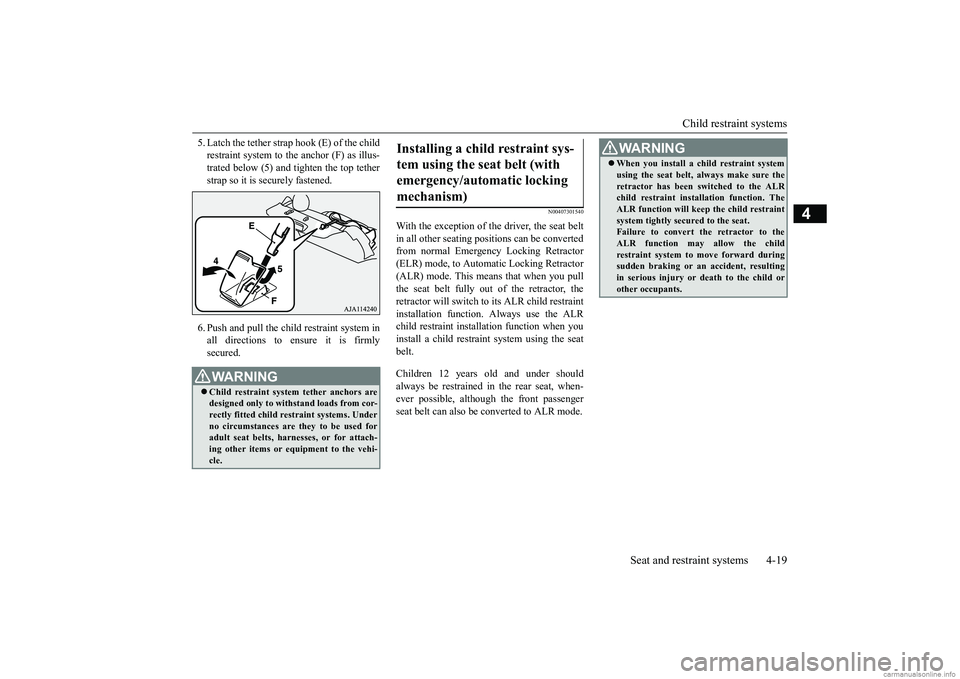
Child restraint systems
Seat and restraint systems 4-19
4
5. Latch the tether strap hook (E) of the child restraint system to the anchor (F) as illus-trated below (5) and tighten the top tether strap so it is securely fastened. 6. Push and pull the chil
d restraint system in
all directions to en
sure it is firmly
secured.
N00407301540
With the exception of the driver, the seat belt in all other seating positions can be converted from normal Emergency Locking Retractor(ELR) mode, to Automatic Locking Retractor (ALR) mode. This mean
s that when you pull
the seat belt fully out of the retractor, the retractor will switch to its ALR child restraint installation function.
Always use the ALR
child restraint instal
lation function when you
install a child restraint system using the seat belt. Children 12 years old and under should always be restrained in the rear seat, when- ever possible, although the front passenger seat belt can also be
converted to ALR mode.
WA R N I N GChild restraint system tether anchors are designed only to with
stand loads from cor-
rectly fitted child restraint systems. Underno circumstances are they to be used for adult seat belts, harnesses, or for attach- ing other items or eq
uipment to the vehi-
cle.
Installing a child restraint sys- tem using the seat belt (with emergency/automatic locking mechanism)
WA R N I N G When you install a child restraint system using the seat belt, al
ways make sure the
retractor has been switched to the ALRchild restraint installation function. The ALR function will keep the child restraint system tightly secured to the seat.Failure to convert the retractor to the ALR function may allow the child restraint system to move forward duringsudden braking
or an accide
nt, resulting
in serious injury or
death to the child or
other occupants.
BK0249600US.book 19 ページ 2017年4月20日 木曜日 午後1時36分
Page 45 of 263
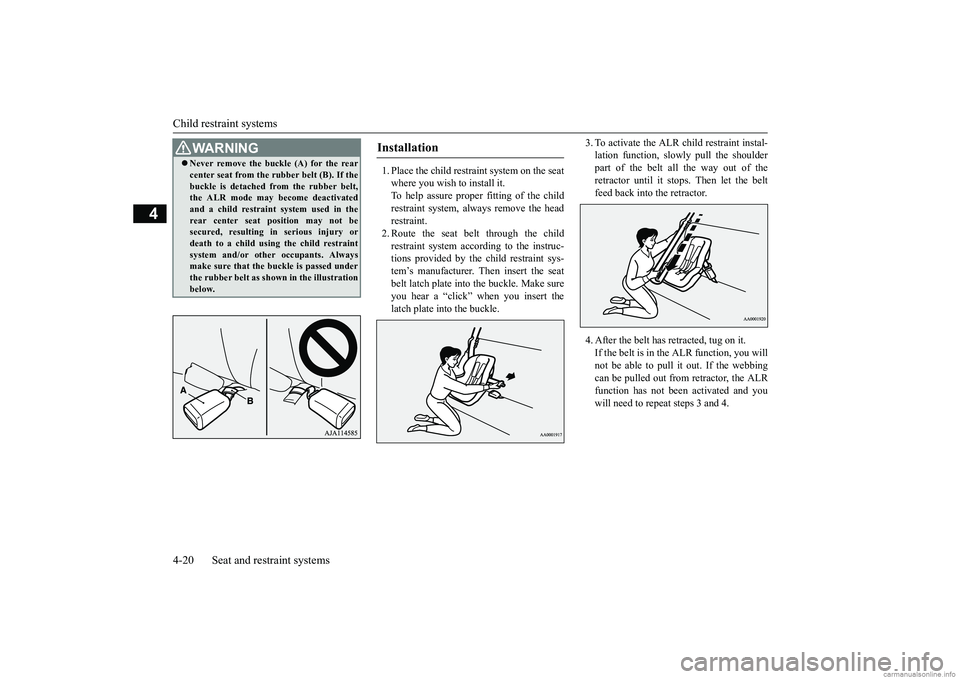
Child restraint systems 4-20 Seat and restraint systems
4
1. Place the child restraint system on the seat where you wish to install it. To help assure proper fitting of the child restraint system, alwa
ys remove the head
restraint. 2. Route the seat belt through the child restraint system acco
rding to the instruc-
tions provided by the child restraint sys- tem’s manufacturer. Then insert the seat belt latch plate into
the buckle. Make sure
you hear a “click” when you insert the latch plate into the buckle.
3. To activate the ALR child restraint instal- lation function, slow
ly pull the shoulder
part of the belt all the way out of the retractor until it stops. Then let the belt feed back into the retractor. 4. After the belt has retracted, tug on it. If the belt is in the ALR function, you will not be able to pull it out. If the webbing can be pulled out from retractor, the ALRfunction has not been activated and you will need to repeat steps 3 and 4.
WA R N I N G Never remove the buckle (A) for the rear center seat from the rubber belt (B). If thebuckle is detached from the rubber belt,the ALR mode may become deactivated and a child restraint system used in the rear center seat
position may not be
secured, resulting in serious injury or death to a child using the child restraint system and/or othe
r occupants. Always
make sure that the buckle is passed under the rubber belt as shown in the illustration below.
Installation
BK0249600US.book 20 ページ 2017年4月20日 木曜日 午後1時36分
Page 46 of 263
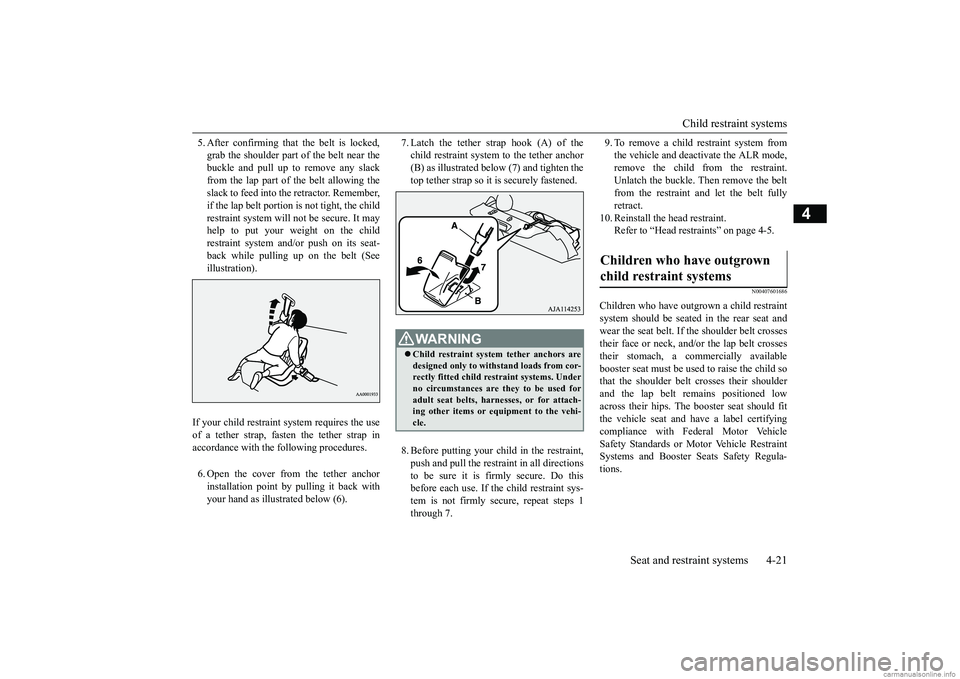
Child restraint systems
Seat and restraint systems 4-21
4
5. After confirming that the belt is locked, grab the shoulder part of the belt near thebuckle and pull up to remove any slack from the lap part of the belt allowing the slack to feed into the retractor. Remember,if the lap belt portion is not tight, the child restraint system will not be secure. It may help to put your weight on the childrestraint system and/or push on its seat- back while pulling up on the belt (See illustration). 6. Open the cover from the tether anchor installation point by
pulling it back with
your hand as illustrated below (6).
7. Latch the tether strap hook (A) of the child restraint system to the tether anchor(B) as illustrated below (7) and tighten the top tether strap so it is securely fastened. 8. Before putting your child in the restraint, push and pull the restra
int in all directions
to be sure it is firmly secure. Do this before each use. If
the child restraint sys-
tem is not firmly secure, repeat steps 1 through 7.
9. To remove a child restraint system from the vehicle and deactivate the ALR mode,remove the child from the restraint. Unlatch the buckle. Then remove the belt from the restraint and let the belt fullyretract.
10. Reinstall the head restraint.
Refer to “Head restraints” on page 4-5.
N00407601686
Children who have outgr
own a child restraint
system should be seated in the rear seat and wear the seat belt. If the shoulder belt crossestheir face or neck, and/
or the lap belt crosses
their stomach, a commercially available booster seat must be used to raise the child sothat the shoulder belt
crosses their shoulder
and the lap belt remains positioned low across their hips. The
booster seat should fit
the vehicle seat and have a label certifying compliance with Federal Motor Vehicle Safety Standards or Mo
tor Vehicle Restraint
Systems and Booster Seats Safety Regula- tions.
If your child restraint system requires the use of a tether strap, fasten the tether strap in accordance with the following procedures.
WA R N I N G Child restraint system tether anchors are designed only to with
stand loads from cor-
rectly fitted child restraint systems. Underno circumstances are they to be used for adult seat belts, harn
esses, or for attach-
ing other items or equipment to the vehi-cle.
Children who have outgrown child restraint systems
BK0249600US.book 21 ページ 2017年4月20日 木曜日 午後1時36分
Page 52 of 263
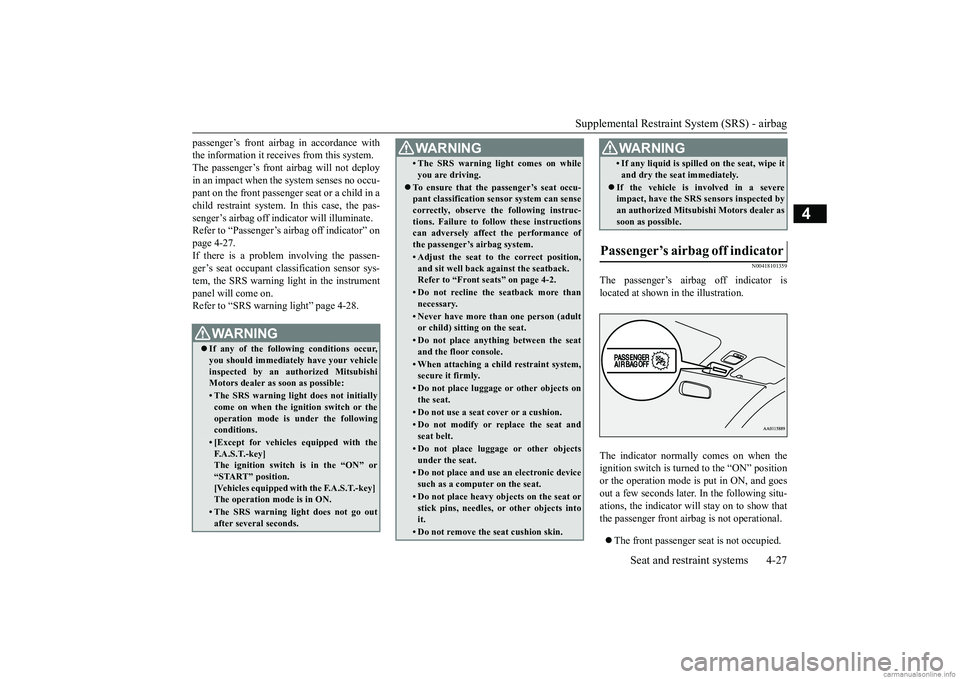
Supplemental Restraint System (SRS) - airbag
Seat and restraint systems 4-27
4
passenger’s front airbag in accordance with the information it receives from this system.The passenger’s front ai
rbag will not deploy
in an impact when the system senses no occu- pant on the front passenger seat or a child in achild restraint system. In this case, the pas- senger’s airbag off indicator will illuminate. Refer to “Passenger’s ai
rbag off indicator” on
page 4-27. If there is a problem involving the passen- ger’s seat occupant cl
assification sensor sys-
tem, the SRS warning light in the instrument panel will come on.Refer to “SRS warning light” page 4-28.
N00418101359
The passenger’s airbag off indicator islocated at shown in the illustration. The indicator normall
y comes on when the
ignition switch is turned to the “ON” position or the operation mode is put in ON, and goes out a few seconds later. In the following situ-ations, the indicator will stay on to show that the passenger front airb
ag is not operational.
The front passenger seat is not occupied.
WA R N I N GIf any of the following conditions occur, you should immediatel
y have your vehicle
inspected by an au
thorized Mitsubishi
Motors dealer as
soon as possible:
• The SRS warning light does not initially come on when the ignition switch or theoperation mode is under the following conditions.• [Except for vehicles equipped with theF. A . S . T. - k e y ] The ignition switch is in the “ON” or“START” position. [Vehicles equipped with the F.A.S.T.-key] The operation mode is in ON.• The SRS warning light does not go outafter several seconds.
• The SRS warning li
ght comes on while
you are driving.
To ensure that the passenger’s seat occu- pant classification sensor system can sense correctly, observe the following instruc-tions. Failure to follow these instructions can adversely affect
the performance of
the passenger’s airbag system.• Adjust the seat to the correct position,and sit well back
against the seatback.
Refer to “Front seats” on page 4-2.• Do not recline the seatback more thannecessary.• Never have more than one person (adultor child) sitting
on the seat.
• Do not place anything between the seat and the floor console.• When attaching a chil
d restraint system,
secure it firmly.• Do not place luggage
or other objects on
the seat.• Do not use a seat cover or a cushion.• Do not modify or replace the seat andseat belt.• Do not place luggage or other objectsunder the seat.• Do not place and use
an electronic device
such as a computer on the seat.• Do not place heavy objects on the seat orstick pins, needles, or other objects intoit.• Do not remove the seat cushion skin.WA R N I N G
• If any liquid is spilled on the seat, wipe itand dry the seat
immediately.
If the vehicle is involved in a severe impact, have the SRS sensors inspected by an authorized
Mitsubishi Motors dealer as
soon as possible.
Passenger’s airbag off indicator
WA R N I N G
BK0249600US.book 27 ページ 2017年4月20日 木曜日 午後1時36分
Page 59 of 263
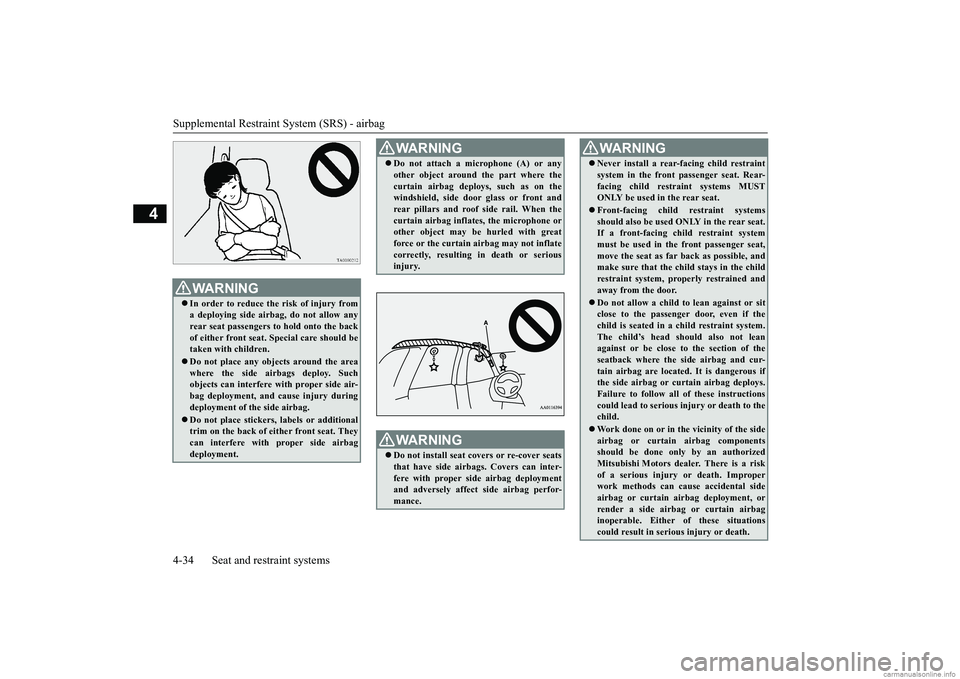
Supplemental Restraint System (SRS) - airbag 4-34 Seat and restraint systems
4
WA R N I N G In order to reduce the risk of injury from a deploying side airbag, do not allow any rear seat passengers to hold onto the back of either front seat. Special care should betaken with children. Do not place any obje
cts around the area
where the side airbags deploy. Such objects can interfere with proper side air- bag deployment, and cause injury duringdeployment of the side airbag. Do not place stickers,
labels or additional
trim on the back of either front seat. They can interfere with proper side airbag deployment.
WA R N I N G Do not attach a microphone (A) or any other object around the part where thecurtain airbag deploys
, such as on the
windshield, side door glass or front and rear pillars and roof
side rail. When the
curtain airbag inflates
, the microphone or
other object may be
hurled with great
force or the curtain airbag may not inflate correctly, resulting in death or seriousinjury.WA R N I N G Do not install seat covers or re-cover seats that have side airb
ags. Covers can inter-
fere with proper si
de airbag deployment
and adversely affect
side airbag perfor-
mance.
Never install a rear-facing child restraint system in the front passenger seat. Rear-facing child restraint systems MUSTONLY be used in the rear seat. Front-facing child restraint systems should also be used ON
LY in the rear seat.
If a front-facing child restraint system must be used in the front passenger seat,move the seat as far back as possible, and make sure that the child stays in the child restraint system, properly restrained andaway from the door. Do not allow a child to
lean against or sit
close to the passenger door, even if the child is seated in a child restraint system. The child’s head sh
ould also not lean
against or be close to the section of the seatback where the side airbag and cur- tain airbag are located. It is dangerous ifthe side airbag or cu
rtain airbag deploys.
Failure to follow all of these instructions could lead to serious in
jury or death to the
child. Work done on or in th
e vicinity of the side
airbag or curtain
airbag components
should be done only
by an authorized
Mitsubishi Motors deal
er. There is a risk
of a serious injury
or death. Improper
work methods can cause accidental side airbag or curtain ai
rbag deployment, or
render a side airb
ag or curtain airbag
inoperable. Either of these situations could result in serious injury or death.WA R N I N G
BK0249600US.book 34 ページ 2017年4月20日 木曜日 午後1時36分
Page 64 of 263
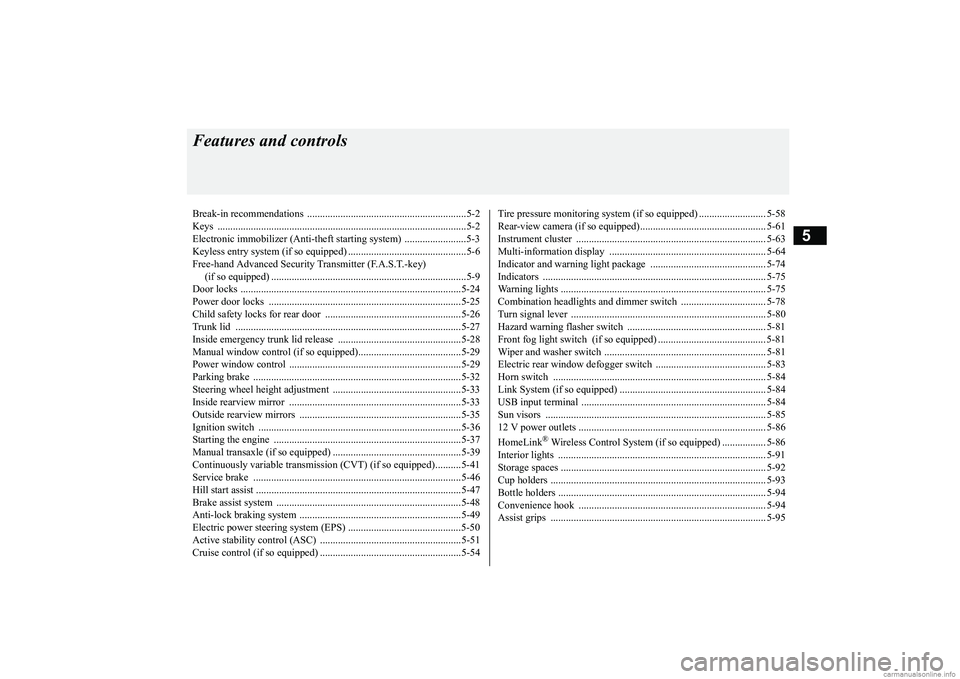
5
Features and controlsBreak-in recommendations ..............................................................5-2 Keys .................................................................................................5-2 Electronic immobilizer (Anti-theft starting system) ........................5-3Keyless entry system (if so equipped) ..............................................5-6 Free-hand Advanced Security
Transmitter (F.A.S.T.-key)
(if so equipped) ............................................................................5-9Door locks ......................................................................................5-24 Power door locks ......
...........
...........
...........
...........
...........
.........
.....5-25
Child safety locks for rear door ..........
...........
.........
.........
.........
.....5-26
Trunk lid ................
............
...........
...........
...........
...........
...........
.....5-27
Inside emergency trunk lid release ................................................5-28 Manual window control (if so equipped)........................................5-29Power window control ...................................................................5-29 Parking brake .................................................................................5-32 Steering wheel height adjustment ..................................................5-33Inside rearview mirror ...................................................................5-33 Outside rearview mirrors ...............................................................5-35 Ignition switch ...............................................................................5-36Starting the engine .........................................................................5-37 Manual transaxle (if so equipped) ..................................................5-39 Continuously variable transmission
(CVT) (if so equipped)..........5-41
Service brake .................................................................................5-46 Hill start assist ................................................................................5-47 Brake assist system ........................................................................5-48Anti-lock braking system ...............................................................5-49 Electric power steering system (EPS) ............................................5-50 Active stability control (ASC) .......................................................5-51Cruise control (if so equipped) .......................................................5-54
Tire pressure monitoring system (if so equipped) .......................... 5-58 Rear-view camera (if so equipped)................................................. 5-61 Instrument cluster .......................................................................... 5-63Multi-information display ............................................................. 5-64 Indicator and warning light package ............................................. 5-74 Indicators ....................................................................................... 5-75Warning lights ................................................................................ 5-75 Combination headlights and dimmer switch ................................. 5-78 Turn signal lever ............................................................................ 5-80Hazard warning flasher switch ...................................................... 5-81 Front fog light switch (if so equipped) .......................................... 5-81 Wiper and washer switch ............................................................... 5-81Electric rear window defogger switch ....
...........
...........
...........
...... 5-83
Horn switch ................................................................................... 5-84 Link System (if so equipped) ......................................................... 5-84USB input terminal ....
...........
...........
...........
...........
...........
............. 5-84
Sun visors ...................................................................................... 5-85 12 V power outlets ......................................................................... 5-86 HomeLink
® Wireless Control System (if so equipped) ................. 5-86
Interior lights ................................................................................. 5-91 Storage spaces ................................................................................ 5-92Cup holders .................................................................................... 5-93 Bottle holders ................................................................................. 5-94 Convenience hook ............
...........
...........
...........
...........
...........
...... 5-94
Assist grips .................................................................................... 5-95
BK0249600US.book 1 ページ 2017年4月20日 木曜日 午後1時36分
Page 66 of 263
![MITSUBISHI MIRAGE G4 2018 (in English) User Guide Electronic immobilizer (Ant
i-theft starting system)
Features and controls 5-3
5
N00509100780
[For vehicles equipped with the Free-hand Advanced Security Transmitter (F.A.S.T.-key)] For information o MITSUBISHI MIRAGE G4 2018 (in English) User Guide Electronic immobilizer (Ant
i-theft starting system)
Features and controls 5-3
5
N00509100780
[For vehicles equipped with the Free-hand Advanced Security Transmitter (F.A.S.T.-key)] For information o](/img/19/34855/w960_34855-65.png)
Electronic immobilizer (Ant
i-theft starting system)
Features and controls 5-3
5
N00509100780
[For vehicles equipped with the Free-hand Advanced Security Transmitter (F.A.S.T.-key)] For information on operations for vehicles equipped with the Free-hand Advanced Secu-rity Transmitter (F.A
.S.T.-key), refer to
“Free-hand Advanced
Security Transmitter
(F.A.S.T.-key): Electr
onic immobilizer (Anti-
theft starting system)” on page 5-19. [Except for vehicles e
quipped with the Free-
hand Advanced Secu
rity Transmitter
(F.A.S.T.-key)]The electronic immobilizer is designed to sig- nificantly reduce the
possibility of vehicle
theft. The purpose of the system is to immo-bilize the vehicle if an invalid start is
1- F.A.S.T.-key
(with electronic immobilizer and key-less entry system function)
2- Emergency key 3- Key number plate
NOTE
The keyless entry key and F.A.S.T.-key are a precision electr
onic device wi
th a built-in
signal transmitter. Please observe the follow- ing in order to prevent damage. • Do not leave where it may be exposed to heat caused by direct sunlight, such as on top of the dashboard. • Do not take the remote
control transmitter
apart. • Do not excessively bend the key or subject it to strong impacts. • Keep the remote control transmitter dry. • Keep away from magne
tic objects such as
key rings.
• Keep away from devi
ces that produce mag-
netism, such as audio systems, computersand televisions. • Keep away from device
s that emit strong
electromagnetic waves, such as cellularphones, wireless devices and high fre- quency equipment (i
ncluding medical
devices). • Do not clean with ultrasonic cleaners. • Do not leave the key where it may be exposed to high temperature or high humid- ity.
If you lose your key, to prevent the theft of the vehicle immediatel
y contact an autho-
rized Mitsubishi Motors dealer. If you notify an authorized Mitsubishi Motors dealer of the key number, they canmake a new key. The key number is stamped on the key number plate. Keep the key num- ber plate in a safe pl
ace separate from the
key itself. No keys other than those registered in advance can be used to start the engine. Refer to “Electronic immobilizer (Anti-theft starting system)” on page 5-3.Refer to “Free-hand Advanced Security Transmitter (F.A.S.T.-key): “Electronic immobilizer (Anti-thef
t starting system)” on
page 5-19.NOTE
When the theft-alarm is in the system opera- tional status, the alar
m operates if a door is
opened after using th
e key, the door lock
knob or the power door lock switch to unlock the vehicle. The system does not enter the preparation status if the keyless entry system or the F.A.S.T.-key was not used to lock the vehi-cle.
Electronic immobilizer (Anti-theft starting system)
NOTE
BK0249600US.book 3 ページ 2017年4月20日 木曜日 午後1時36分
Page 67 of 263
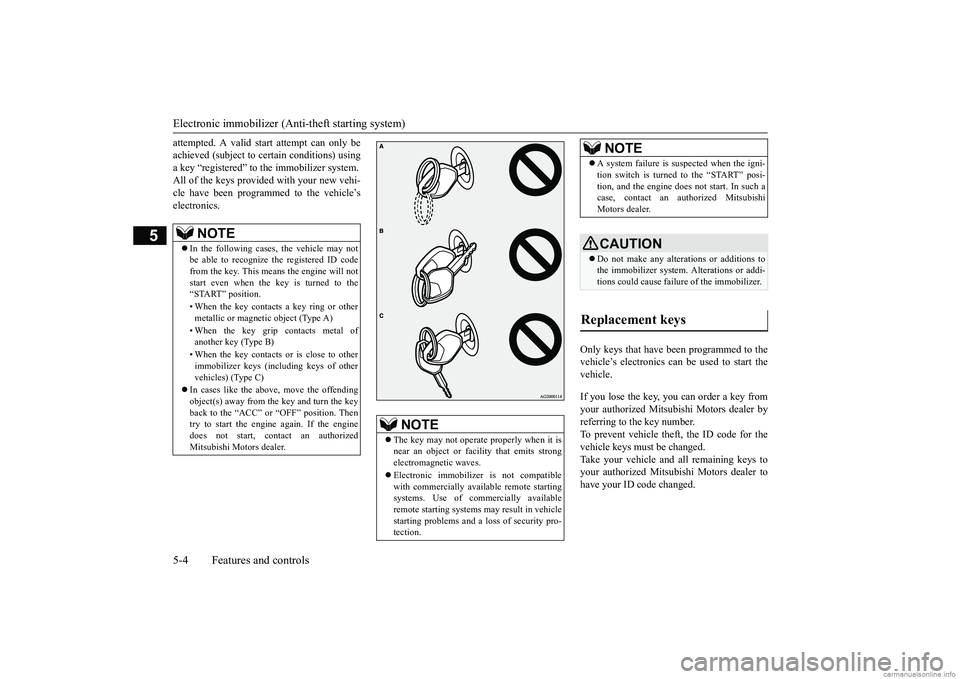
Electronic immobilizer (Anti-theft starting system) 5-4 Features and controls
5
attempted. A valid st
art attempt can only be
achieved (subject to ce
rtain conditions) using
a key “registered” to the immobilizer system. All of the keys provided with your new vehi- cle have been program
med to the vehicle’s
electronics.
Only keys that have been programmed to the vehicle’s electronics can be used to start thevehicle. If you lose the key, you can order a key from your authorized Mitsubi
shi Motors dealer by
referring to the key number.To prevent vehicle theft, the ID code for the vehicle keys must be changed. Take your vehicle and all remaining keys toyour authorized Mitsubishi Motors dealer to have your ID code changed.
NOTE
In the following cases, the vehicle may not be able to recognize
the registered ID code
from the key. This mean
s the engine will not
start even when the key is turned to the “START” position. • When the key contacts a key ring or other metallic or magnet
ic object (Type A)
• When the key grip contacts metal of another key (Type B) • When the key contacts
or is close to other
immobilizer keys (inc
luding keys of other
vehicles) (Type C)
In cases like the above, move the offending object(s) away from the key and turn the key back to the “ACC” or
“OFF” position. Then
try to start the engine again. If the enginedoes not start, cont
act an authorized
Mitsubishi Motors dealer.
NOTE
The key may not operate
properly when it is
near an object or facility that emits strong electromagnetic waves. Electronic immobilizer is not compatible with commercially available remote startingsystems. Use of commercially available remote starting systems may result in vehicle starting problems and a loss of security pro-tection.
A system failure is suspected when the igni- tion switch is turned to the “START” posi-tion, and the engine does
not start. In such a
case, contact an au
thorized Mitsubishi
Motors dealer.CAUTION Do not make any altera
tions or additions to
the immobilizer system.
Alterations or addi-
tions could cause failure of the immobilizer.
Replacement keys
NOTE
BK0249600US.book 4 ページ 2017年4月20日 木曜日 午後1時36分
Page 72 of 263
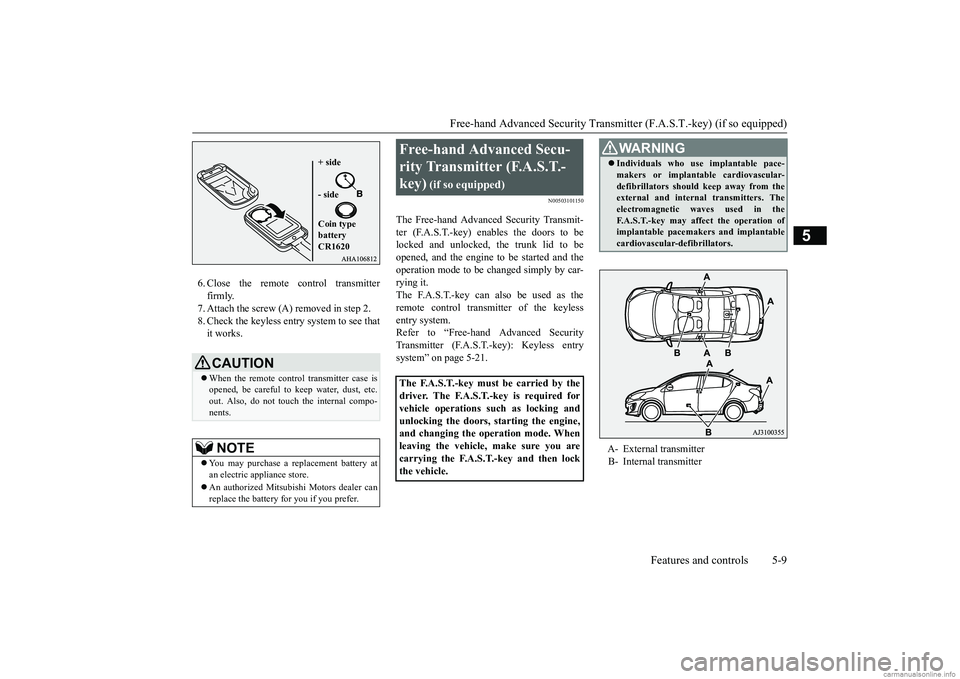
Free-hand Advanced Securi
ty Transmitter (F.A.S.T.-key) (if so equipped)
Features and controls 5-9
5
6. Close the remote control transmitter firmly.7. Attach the screw (A) removed in step 2. 8. Check the keyless entry system to see that it works.
N00503101150
The Free-hand Advanced Security Transmit-ter (F.A.S.T.-key) enables the doors to belocked and unlocked, the trunk lid to be opened, and the engine to be started and the operation mode to be
changed simply by car-
rying it. The F.A.S.T.-key can also be used as theremote control transmitter of the keyless entry system. Refer to “Free-hand Advanced SecurityTransmitter (F.A.S.T.-
key): Keyless entry
system” on page 5-21.
CAUTION When the remote control transmitter case is opened, be careful to keep water, dust, etc. out. Also, do not touch the internal compo-nents.NOTE
You may purchase a replacement battery at an electric appliance store. An authorized Mitsubish
i Motors dealer can
replace the battery for you if you prefer.
+ side - side Coin type battery CR1620
Free-hand Advanced Secu- rity Transmitter (F.A.S.T.-key)
(if so equipped)
The F.A.S.T.-key must be carried by the driver. The F.A.S.T.-key is required forvehicle operations su
ch as locking and
unlocking the doors,
starting the engine,
and changing the operation mode. When leaving the vehicle,
make sure you are
carrying the F.A.S.T.-key and then lockthe vehicle.
WA R N I N G Individuals who use
implantable pace-
makers or implanta
ble cardiovascular-
defibrillators
should keep away from the
external and internal
transmitters. The
electromagnetic waves used in the F.A.S.T.-key may affect the operation ofimplantable pacemakers and implantable cardiovascular-defibrillators.A- External transmitter B- Internal transmitter
BK0249600US.book 9 ページ 2017年4月20日 木曜日 午後1時36分
Page 73 of 263
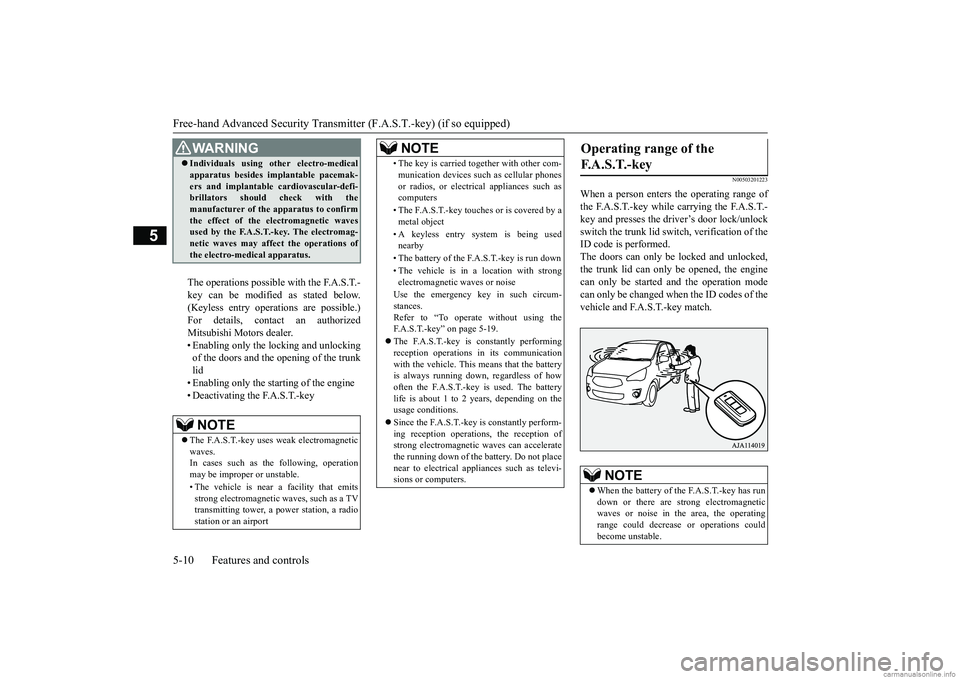
Free-hand Advanced
Security Transmitter (F.A.S
.T.-key) (if so equipped)
5-10 Features and controls
5
The operations possible with the F.A.S.T.- key can be modified as stated below. (Keyless entry operations are possible.) For details, contact an authorizedMitsubishi Motors dealer. • Enabling only the locking and unlocking of the doors and the opening of the trunklid • Enabling only the starting of the engine • Deactivating the F.A.S.T.-key
N00503201223
When a person enters the operating range ofthe F.A.S.T.-key while carrying the F.A.S.T.-key and presses the driver’s door lock/unlock switch the trunk lid switc
h, verification of the
ID code is performed.The doors can only be locked and unlocked, the trunk lid can only
be opened, the engine
can only be started and the operation mode can only be changed when the ID codes of the vehicle and F.A.S.T.-key match.
WA R N I N G Individuals using ot
her electro-medical
apparatus besides implantable pacemak-ers and implantable
cardiovascular-defi-
brillators should check with the manufacturer of the apparatus to confirm the effect of the electromagnetic wavesused by the F.A.S.T.-key. The electromag- netic waves may affect
the operations of
the electro-medical apparatus.NOTE
The F.A.S.T.-key uses weak electromagnetic waves. In cases such as the following, operation may be improper or unstable. • The vehicle is near a facility that emits strong electromagnetic
waves, such as a TV
transmitting tower, a pow
er station, a radio
station or an airport
• The key is carried together with other com- munication devices such
as cellular phones
or radios, or electrical appliances such ascomputers • The F.A.S.T.-key touches or is covered by a metal object • A keyless entry system is being used nearby • The battery of the F.A.S.T.-key is run down• The vehicle is in a location with strong electromagnetic
waves or noise
Use the emergency key in such circum- stances.Refer to “To operate without using the F.A.S.T.-key” on page 5-19. The F.A.S.T.-key is constantly performing reception operations
in its communication
with the vehicle. This means that the batteryis always running down, regardless of how often the F.A.S.T.-key is used. The battery life is about 1 to 2 years, depending on theusage conditions. Since the F.A.S.T.-key is constantly perform- ing reception operati
ons, the reception of
strong electromagnetic
waves can accelerate
the running down of the ba
ttery. Do not place
near to electrical appliances such as televi- sions or computers.NOTE
Operating range of the F. A . S . T. - k e y
NOTE
When the battery of the F.A.S.T.-key has run down or there are st
rong electromagnetic
waves or noise in the area, the operating range could decrease
or operations could
become unstable.
BK0249600US.book 10 ページ 2017年4月20日 木曜日 午後1時36分